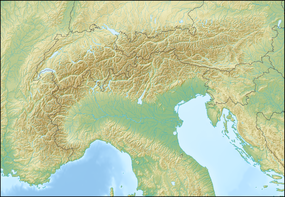
Back دولوميت (سلسلة جبلية) Arabic دولوميت ARZ Dolomites AST Dolomitn BAR Даламітавыя Альпы Byelorussian Доломити (планинска верига) Bulgarian ডলোমাইটস Bengali/Bangla Dolomitoù Breton Dolomites Catalan Dolomiti CEB
| Dolomites | |
|---|---|
 Valley of Funes, 2018 | |
| Highest point | |
| Peak | Marmolada |
| Elevation | 3,343 m (10,968 ft) |
| Coordinates | 46°26′N 11°51′E / 46.433°N 11.850°E |
| Dimensions | |
| Area | 15,942 km2 (6,155 sq mi) |
| Naming | |
| Native name | |
| Pronunciation | [doloˈmiːti] |
| Geography | |
| Country | |
| Regions | Veneto, Trentino-Alto Adige/Südtirol and Friuli-Venezia Giulia |
| Parent range | Alps |
| Geology | |
| Orogeny | Alpine orogeny |
| Age of rock | Mostly Triassic |
| Type of rock | Dolomite, sedimentary rocks and volcanic rocks |
 | |
| Criteria | Natural: (vii)(viii) |
| Reference | 1237 |
| Inscription | 2009 (33rd Session) |
| Area | 141,902.8 ha (350,649 acres) |
| Buffer zone | 89,266.7 ha (220,583 acres) |
The Dolomites (Italian: Dolomiti [doloˈmiːti][a]), also known as the Dolomite Mountains, Dolomite Alps or Dolomitic Alps, are a mountain range in Northeast Italy. They are in Veneto, Trentino-Alto Adige/Südtirol and Friuli-Venezia Giulia.
On 26 June 2009, the Dolomites became a UNESCO World Heritage Site.[1][2]
Cite error: There are <ref group=lower-alpha> tags or {{efn}} templates on this page, but the references will not show without a {{reflist|group=lower-alpha}} template or {{notelist}} template (see the help page).
- ↑ "The Dolomites UNESCO World Heritage Site". Dolomites UNESCO World Heritage (in English, German, and Italian). Archived from the original on 4 February 2024. Retrieved 4 May 2024.
- ↑ "The Dolomites". UNESCO (in English, French, Arabic, Spanish, Japanese, and Dutch). Archived from the original on 25 April 2024. Retrieved 4 May 2024.
